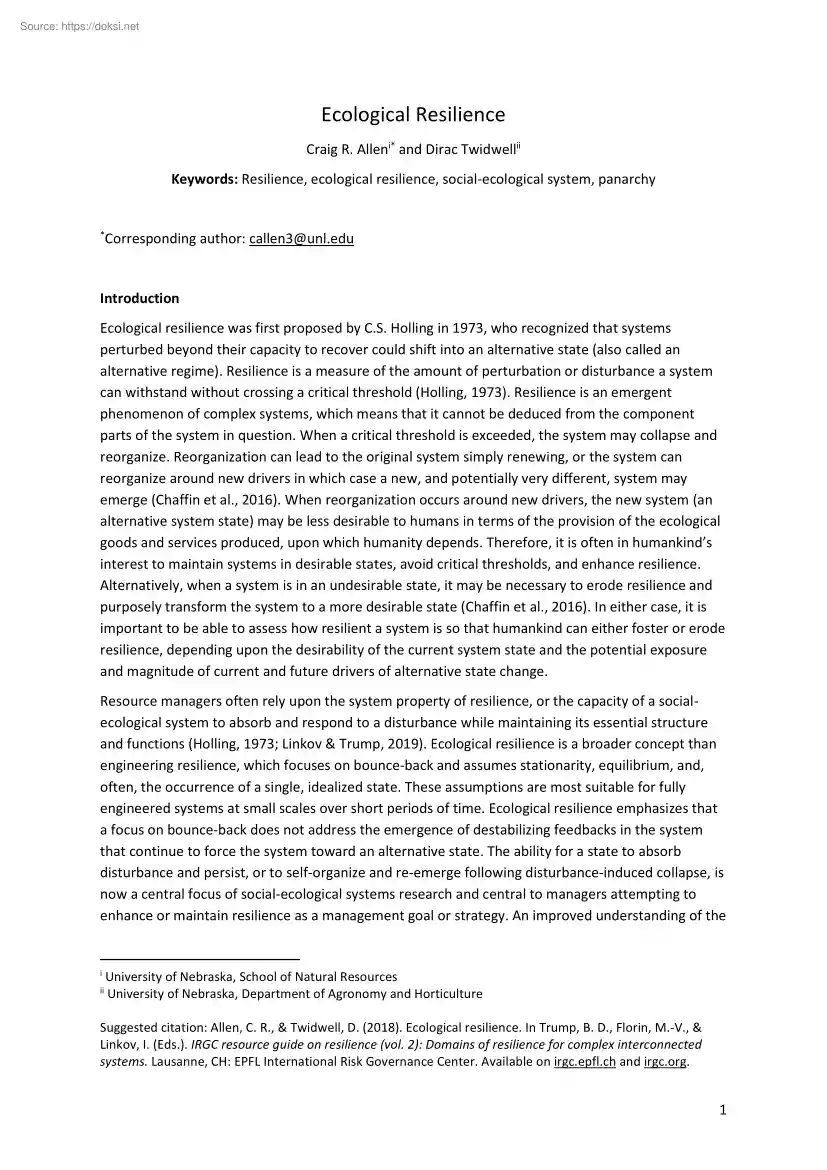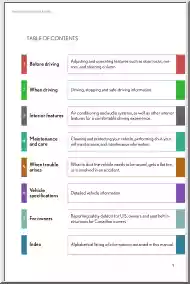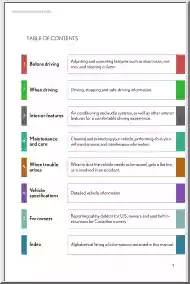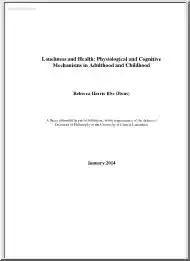Please log in to read this in our online viewer!

Please log in to read this in our online viewer!
No comments yet. You can be the first!
What did others read after this?
Content extract
Ecological Resilience Craig R. Alleni* and Dirac Twidwellii Keywords: Resilience, ecological resilience, social-ecological system, panarchy * Corresponding author: callen3@unl.edu Introduction Ecological resilience was first proposed by C.S Holling in 1973, who recognized that systems perturbed beyond their capacity to recover could shift into an alternative state (also called an alternative regime). Resilience is a measure of the amount of perturbation or disturbance a system can withstand without crossing a critical threshold (Holling, 1973). Resilience is an emergent phenomenon of complex systems, which means that it cannot be deduced from the component parts of the system in question. When a critical threshold is exceeded, the system may collapse and reorganize. Reorganization can lead to the original system simply renewing, or the system can reorganize around new drivers in which case a new, and potentially very different, system may emerge (Chaffin et al., 2016) When
reorganization occurs around new drivers, the new system (an alternative system state) may be less desirable to humans in terms of the provision of the ecological goods and services produced, upon which humanity depends. Therefore, it is often in humankind’s interest to maintain systems in desirable states, avoid critical thresholds, and enhance resilience. Alternatively, when a system is in an undesirable state, it may be necessary to erode resilience and purposely transform the system to a more desirable state (Chaffin et al., 2016) In either case, it is important to be able to assess how resilient a system is so that humankind can either foster or erode resilience, depending upon the desirability of the current system state and the potential exposure and magnitude of current and future drivers of alternative state change. Resource managers often rely upon the system property of resilience, or the capacity of a socialecological system to absorb and respond to a disturbance while
maintaining its essential structure and functions (Holling, 1973; Linkov & Trump, 2019). Ecological resilience is a broader concept than engineering resilience, which focuses on bounce-back and assumes stationarity, equilibrium, and, often, the occurrence of a single, idealized state. These assumptions are most suitable for fully engineered systems at small scales over short periods of time. Ecological resilience emphasizes that a focus on bounce-back does not address the emergence of destabilizing feedbacks in the system that continue to force the system toward an alternative state. The ability for a state to absorb disturbance and persist, or to self-organize and re-emerge following disturbance-induced collapse, is now a central focus of social-ecological systems research and central to managers attempting to enhance or maintain resilience as a management goal or strategy. An improved understanding of the i ii University of Nebraska, School of Natural Resources University of
Nebraska, Department of Agronomy and Horticulture Suggested citation: Allen, C. R, & Twidwell, D (2018) Ecological resilience In Trump, B D, Florin, M-V, & Linkov, I. (Eds) IRGC resource guide on resilience (vol 2): Domains of resilience for complex interconnected systems. Lausanne, CH: EPFL International Risk Governance Center Available on irgcepflch and irgcorg 1 boundaries of resilience, the thresholds that separate one state of a system from alternative states, and how social and ecological system components interact to reinforce, or alternatively degrade, resilience may help resource managers avoid or facilitate regime shifts so that desired ecosystem services are maintained or restored. Coupling this information to knowledge of the likelihood of a regime change, and the potential for novel drivers to arise and trigger alternative state change following catastrophic change, is an important component of assessing the risk of systems to perturbation. Ecological
resilience and risk Complex systems are generally understood to be open and self-organizing, have inherent unpredictability and uncertainty, non-linear dynamics, and emergent phenomena (EPFL International Risk Governance Center [IRGC], 2018). Complex systems are self-organizing because there is no central authority directing system components; complexity arises over time from many simple interactions. Complex system behavior cannot be inferred or predicted by summing system components, because complex systems have non-linear dynamics. Non-linear dynamics occur when small changes have a disproportionately large effect. For example, phosphorus levels in a lake may steadily rise over time, with no apparent consequence to the lake, until they exceed a critical threshold and the lake abruptly tips into a new regime, becoming eutrophic and prone to algae blooms – and less desirable to humans. Ecosystems and other complex systems change in response to changing conditions, which has
consequences for how we understand ecosystems and how we manage them. Understanding the resilience of ecosystems is important, because humanity relies upon a consistent production of ecological goods and services, such as drinking water, crop pollination, soil renewal and regeneration, abundant marine life to eat, carbon dioxide storage, and more. Considering that risk is the uncertain negative (or undesirable) consequence of an event or an activity with regards to something that humans value, risk approaches should focus on identifying critical thresholds, because when an ecosystem’s resilience is exceeded and the system shifts into an alternative state, the system may become less desirable from a human perspective, and produce fewer goods and services, which can be a risk to those affected. It is often apparent when the resilience of an ecosystem has been exceeded as the system discernibly changes, as when a lake shifts from a clear to a turbid state, but it is difficult to predict
when that shift might occur because of the non-linear dynamics of complex systems. Small changes to the system may have disproportionately large consequences, and vice versa. Ecological resilience should not be confused with engineering resilience, which emphasizes the ability of a system to perform a specific task consistently and predictably, and to re-establish performance quickly should a disturbance occur. The consequences of applying this type of thinking to the management of complex systems, especially social-ecological systems, is problematic because complex adaptive systems cannot be treated as an engineered system with predictable and consistent outputs. Ecosystems do not have an equilibrium where opposing forces are in balance. Rather, an ecosystem exists within a regime, and within a particular regime, the abundance and composition of the component parts that comprise that regime may change quite dynamically over time. In a risk context this means that compounded
perturbations derived from hazards or global change can have unexpected and highly uncertain effects on natural resources, humans and societies. These effects can manifest in regime shifts, potentially spurring environmental degradation that might lock a social ecological system into an undesirable system state that can be difficult to reverse, and as a 2 consequence of economic crises, conflict, human health problems, and the presence of hysteresis in the system. Consequences of exceeding resilience A premise of any complex social-ecological system is that surprise and uncertainty are inherent to the system. Achieving and managing trade-offs between benefits for humanity while reducing risks is difficult and does not adequately address surprise and uncertainty in system behaviour. Social ecological system management and governance have therefore, to a large extent, struggled to ensure the maintenance of ecological regimes that are desirable for humans in terms of consistent
delivery of ecological goods and services while systems undergo change. Regime shifts, such as the collapse of commercial fisheries or agricultural systems, have often been the consequence of the sustained overuse of natural resources. Given that risk and undesirability are similar concepts (risk being the undesirable consequence of uncertainty), resilience-based management decreases risk in two ways. First, when systems are in a desirable state for humans, management can focus on fostering and enhancing the resilience needed to maintain this regime by assuring that functional attributes relevant for processes that deliver ecosystem services are diverse and imbricated. This reduces the chance that the system shifts to an undesirable state if subject to unsustainable stress, with the risk that the system may no longer be able to provide the services it is intended to provide. However, prioritizing resilience in management and planning has often proven difficult. Optimizing resource use
and dampening variability or uncertainty in harvest use or efficiency has long-been prioritized in management, and while important, often erodes resilience by limiting the system’s use of state space, which may in turn narrow the basin of attraction for a desired state, making collapse more likely. Second, systems in undesirable states can also be highly resilient, yet present risks to assets or people depending on these systems (for example, people living in poverty traps). Where systems are in undesirable states resistant to change, that is, when an undesirable state is resilient, it may be necessary to reduce the resilience of the system and to induce a shift in the system to a regime that is more desirable, and then to manage the system to foster the regime of this desirable state. Understanding that complex systems can have critical thresholds affects risk equations. When there is hysteresis present in the system, risks must be assessed cautiously, and management should be
correspondingly cautious. Crossing a critical threshold can have catastrophic consequences, and reversal can require much more input than was required to change the system in the first place. Adaptation and transformation In 2004, Walker, Holling, Carpenter, and Kinzig introduced “transformability” as an attribute of complex systems that defined the potential dynamics and future trajectory of a system. In this context, the authors defined transformability as the “capacity to create a fundamentally new system when ecological, economic, or social conditions make the existing system untenable” (Walker et al., 2004). At the scale of an SES, a transformation is a deliberate, societally-initiated process of pushing a system across a threshold by “a phased introduction of one or more new state variables” (Folke et al., 2010) This definition of transformation differs from others, which claim that there are two types of transformative change: intentional or deliberate; and
unintentional or unexpected as a result of a process or event. In each of these cases, intentional and unintentional, a social ecological system 3 undergoes a regime shift and a threshold is crossed. However, we define a transformation as occurring when the regime shift is a direct result of human planning and action, human agency. The phenomenon of transformation is scale-dependent, multilevel, and can be system-wide or can be nested as personal, organizational, or within other levels of subsystem transformation. Therefore, a transformation requires purposefully exceeding the resilience of a system in an undesirable state, and then, through human agency, fostering a reorganization into a more desired state. The concept of panarchy (Allen, Angeler, Garmestani, Gunderson, & Holling, 2014) is central to understanding transformation. The capacity to transform is likely the product of a nested system influenced by cross-scale interactions from above and below, and highly
“dependent on the nature and extent of adaptive actions being taken at other interacting scales”. For example, larger-scale transformation may only occur as personal or individual transformations are scaled-up to forge the collective capacity to drive change. In this context, deliberate transformation has also been referred to as directional or purpose transformation. Regardless, transformation describes change in the dominant processes and structures that maintain a complex social ecological system in a particular state. These factors vary for any SES at a particular scale, but can include processes and associated feedbacks such as biophysical cycles, ecological hierarchies, human activity or social institutions. It follows that transformative governance builds capacity of society to alter these processes in order to foster a new regime in social ecological systems that achieve societal priorities. Transformative governance is an emerging approach to the management of complex
systems with the capacity to catalyze and guide regime shifts in systems at multiple scales. The process of transformation requires disrupting internal or external drivers, or introducing new drivers, to displace the entrenched forms environmental governance and to provide space for innovation, and thereby foster a fundamental, positive, change in the nature of the affected social ecological system. A challenge to resilience theory is that it is very easy to recognize a system that has undergone a regime shift, but very difficult to recognize when the resilience of a system has been compromised. Quantification of the resilience of systems is in its infancy and remains poorly developed, though there have been recent advances in detecting early warning of impending regime shifts, usually focusing on rising variance in key parameters of the ecological system in question (Angeler & Allen, 2016). The development of leading indicators is critical to managing for resilience, and therefore
sound environmental management. Annotated bibliography Allen, C. R, Angeler, D G, Garmestani, A S, Gunderson, L H, & Holling, C S (2014) Panarchy: theory and application. Ecosystems, 17(3), 578-589 Reviews the development, use and evidence for panarchical structure in social, ecological and social-ecological systems. Angeler, D. G, & Allen, C R (2016) Quantifying resilience Journal of Applied Ecology, 53(3), 617624 https://doiorg/101111/1365-266412649 Provides an overview of resilience definitions, and introduces a special feature focused on various approaches to quantifying resilience. Chaffin, B. C, Garmestani, A S, Gunderson, L H, Benson, M H, Angeler, D A, Arnold, C, Allen, C.R (2016) Transformative environmental governance Annual Review of Environment and Resources, 41, 399-423. https://doiorg/101146/annurev-environ-110615-085817 Introduces and defines the concept of transformative governance. 4 EPFL International Risk Governance Center [IRGC]. (2018) Guidelines for
the Governance of Systemic Risks. Lausanne: EPFL International Risk Governance Center Provides multiple perspectives on complex adaptive systems and their interconnectivity. Holling, C.S 1973 Resilience and stability of ecological systems Annual Review of Ecology and Systematics, 4, 1–23. Seminal article that introduces and defines the concept of ecological resilience. Linkov, I., & Trump, BD (2019) The Science and Practice of Resilience Springer International Publishing. Discusses multiple perspectives of risk and resilience from an engineering and public health context. Folke, C., Carpenter, S R, Walker, B, Scheffer, M, Chapin, T, & Rockström, J (2010) Resilience thinking: integrating resilience, adaptability and transformability. Ecology and Society, 15(4), 20. Further refines the concept of transformability, and places it in a panarchy and resilience context. Walker, B., Holling, C S, Carpenter, S R, & Kinzig, A (2004) Resilience, adaptability and transformability in
social–ecological systems. Ecology and Society, 9(2), 5 Article introducing the relationship between resilience and the concepts of adaptation and transformation. 5
reorganization occurs around new drivers, the new system (an alternative system state) may be less desirable to humans in terms of the provision of the ecological goods and services produced, upon which humanity depends. Therefore, it is often in humankind’s interest to maintain systems in desirable states, avoid critical thresholds, and enhance resilience. Alternatively, when a system is in an undesirable state, it may be necessary to erode resilience and purposely transform the system to a more desirable state (Chaffin et al., 2016) In either case, it is important to be able to assess how resilient a system is so that humankind can either foster or erode resilience, depending upon the desirability of the current system state and the potential exposure and magnitude of current and future drivers of alternative state change. Resource managers often rely upon the system property of resilience, or the capacity of a socialecological system to absorb and respond to a disturbance while
maintaining its essential structure and functions (Holling, 1973; Linkov & Trump, 2019). Ecological resilience is a broader concept than engineering resilience, which focuses on bounce-back and assumes stationarity, equilibrium, and, often, the occurrence of a single, idealized state. These assumptions are most suitable for fully engineered systems at small scales over short periods of time. Ecological resilience emphasizes that a focus on bounce-back does not address the emergence of destabilizing feedbacks in the system that continue to force the system toward an alternative state. The ability for a state to absorb disturbance and persist, or to self-organize and re-emerge following disturbance-induced collapse, is now a central focus of social-ecological systems research and central to managers attempting to enhance or maintain resilience as a management goal or strategy. An improved understanding of the i ii University of Nebraska, School of Natural Resources University of
Nebraska, Department of Agronomy and Horticulture Suggested citation: Allen, C. R, & Twidwell, D (2018) Ecological resilience In Trump, B D, Florin, M-V, & Linkov, I. (Eds) IRGC resource guide on resilience (vol 2): Domains of resilience for complex interconnected systems. Lausanne, CH: EPFL International Risk Governance Center Available on irgcepflch and irgcorg 1 boundaries of resilience, the thresholds that separate one state of a system from alternative states, and how social and ecological system components interact to reinforce, or alternatively degrade, resilience may help resource managers avoid or facilitate regime shifts so that desired ecosystem services are maintained or restored. Coupling this information to knowledge of the likelihood of a regime change, and the potential for novel drivers to arise and trigger alternative state change following catastrophic change, is an important component of assessing the risk of systems to perturbation. Ecological
resilience and risk Complex systems are generally understood to be open and self-organizing, have inherent unpredictability and uncertainty, non-linear dynamics, and emergent phenomena (EPFL International Risk Governance Center [IRGC], 2018). Complex systems are self-organizing because there is no central authority directing system components; complexity arises over time from many simple interactions. Complex system behavior cannot be inferred or predicted by summing system components, because complex systems have non-linear dynamics. Non-linear dynamics occur when small changes have a disproportionately large effect. For example, phosphorus levels in a lake may steadily rise over time, with no apparent consequence to the lake, until they exceed a critical threshold and the lake abruptly tips into a new regime, becoming eutrophic and prone to algae blooms – and less desirable to humans. Ecosystems and other complex systems change in response to changing conditions, which has
consequences for how we understand ecosystems and how we manage them. Understanding the resilience of ecosystems is important, because humanity relies upon a consistent production of ecological goods and services, such as drinking water, crop pollination, soil renewal and regeneration, abundant marine life to eat, carbon dioxide storage, and more. Considering that risk is the uncertain negative (or undesirable) consequence of an event or an activity with regards to something that humans value, risk approaches should focus on identifying critical thresholds, because when an ecosystem’s resilience is exceeded and the system shifts into an alternative state, the system may become less desirable from a human perspective, and produce fewer goods and services, which can be a risk to those affected. It is often apparent when the resilience of an ecosystem has been exceeded as the system discernibly changes, as when a lake shifts from a clear to a turbid state, but it is difficult to predict
when that shift might occur because of the non-linear dynamics of complex systems. Small changes to the system may have disproportionately large consequences, and vice versa. Ecological resilience should not be confused with engineering resilience, which emphasizes the ability of a system to perform a specific task consistently and predictably, and to re-establish performance quickly should a disturbance occur. The consequences of applying this type of thinking to the management of complex systems, especially social-ecological systems, is problematic because complex adaptive systems cannot be treated as an engineered system with predictable and consistent outputs. Ecosystems do not have an equilibrium where opposing forces are in balance. Rather, an ecosystem exists within a regime, and within a particular regime, the abundance and composition of the component parts that comprise that regime may change quite dynamically over time. In a risk context this means that compounded
perturbations derived from hazards or global change can have unexpected and highly uncertain effects on natural resources, humans and societies. These effects can manifest in regime shifts, potentially spurring environmental degradation that might lock a social ecological system into an undesirable system state that can be difficult to reverse, and as a 2 consequence of economic crises, conflict, human health problems, and the presence of hysteresis in the system. Consequences of exceeding resilience A premise of any complex social-ecological system is that surprise and uncertainty are inherent to the system. Achieving and managing trade-offs between benefits for humanity while reducing risks is difficult and does not adequately address surprise and uncertainty in system behaviour. Social ecological system management and governance have therefore, to a large extent, struggled to ensure the maintenance of ecological regimes that are desirable for humans in terms of consistent
delivery of ecological goods and services while systems undergo change. Regime shifts, such as the collapse of commercial fisheries or agricultural systems, have often been the consequence of the sustained overuse of natural resources. Given that risk and undesirability are similar concepts (risk being the undesirable consequence of uncertainty), resilience-based management decreases risk in two ways. First, when systems are in a desirable state for humans, management can focus on fostering and enhancing the resilience needed to maintain this regime by assuring that functional attributes relevant for processes that deliver ecosystem services are diverse and imbricated. This reduces the chance that the system shifts to an undesirable state if subject to unsustainable stress, with the risk that the system may no longer be able to provide the services it is intended to provide. However, prioritizing resilience in management and planning has often proven difficult. Optimizing resource use
and dampening variability or uncertainty in harvest use or efficiency has long-been prioritized in management, and while important, often erodes resilience by limiting the system’s use of state space, which may in turn narrow the basin of attraction for a desired state, making collapse more likely. Second, systems in undesirable states can also be highly resilient, yet present risks to assets or people depending on these systems (for example, people living in poverty traps). Where systems are in undesirable states resistant to change, that is, when an undesirable state is resilient, it may be necessary to reduce the resilience of the system and to induce a shift in the system to a regime that is more desirable, and then to manage the system to foster the regime of this desirable state. Understanding that complex systems can have critical thresholds affects risk equations. When there is hysteresis present in the system, risks must be assessed cautiously, and management should be
correspondingly cautious. Crossing a critical threshold can have catastrophic consequences, and reversal can require much more input than was required to change the system in the first place. Adaptation and transformation In 2004, Walker, Holling, Carpenter, and Kinzig introduced “transformability” as an attribute of complex systems that defined the potential dynamics and future trajectory of a system. In this context, the authors defined transformability as the “capacity to create a fundamentally new system when ecological, economic, or social conditions make the existing system untenable” (Walker et al., 2004). At the scale of an SES, a transformation is a deliberate, societally-initiated process of pushing a system across a threshold by “a phased introduction of one or more new state variables” (Folke et al., 2010) This definition of transformation differs from others, which claim that there are two types of transformative change: intentional or deliberate; and
unintentional or unexpected as a result of a process or event. In each of these cases, intentional and unintentional, a social ecological system 3 undergoes a regime shift and a threshold is crossed. However, we define a transformation as occurring when the regime shift is a direct result of human planning and action, human agency. The phenomenon of transformation is scale-dependent, multilevel, and can be system-wide or can be nested as personal, organizational, or within other levels of subsystem transformation. Therefore, a transformation requires purposefully exceeding the resilience of a system in an undesirable state, and then, through human agency, fostering a reorganization into a more desired state. The concept of panarchy (Allen, Angeler, Garmestani, Gunderson, & Holling, 2014) is central to understanding transformation. The capacity to transform is likely the product of a nested system influenced by cross-scale interactions from above and below, and highly
“dependent on the nature and extent of adaptive actions being taken at other interacting scales”. For example, larger-scale transformation may only occur as personal or individual transformations are scaled-up to forge the collective capacity to drive change. In this context, deliberate transformation has also been referred to as directional or purpose transformation. Regardless, transformation describes change in the dominant processes and structures that maintain a complex social ecological system in a particular state. These factors vary for any SES at a particular scale, but can include processes and associated feedbacks such as biophysical cycles, ecological hierarchies, human activity or social institutions. It follows that transformative governance builds capacity of society to alter these processes in order to foster a new regime in social ecological systems that achieve societal priorities. Transformative governance is an emerging approach to the management of complex
systems with the capacity to catalyze and guide regime shifts in systems at multiple scales. The process of transformation requires disrupting internal or external drivers, or introducing new drivers, to displace the entrenched forms environmental governance and to provide space for innovation, and thereby foster a fundamental, positive, change in the nature of the affected social ecological system. A challenge to resilience theory is that it is very easy to recognize a system that has undergone a regime shift, but very difficult to recognize when the resilience of a system has been compromised. Quantification of the resilience of systems is in its infancy and remains poorly developed, though there have been recent advances in detecting early warning of impending regime shifts, usually focusing on rising variance in key parameters of the ecological system in question (Angeler & Allen, 2016). The development of leading indicators is critical to managing for resilience, and therefore
sound environmental management. Annotated bibliography Allen, C. R, Angeler, D G, Garmestani, A S, Gunderson, L H, & Holling, C S (2014) Panarchy: theory and application. Ecosystems, 17(3), 578-589 Reviews the development, use and evidence for panarchical structure in social, ecological and social-ecological systems. Angeler, D. G, & Allen, C R (2016) Quantifying resilience Journal of Applied Ecology, 53(3), 617624 https://doiorg/101111/1365-266412649 Provides an overview of resilience definitions, and introduces a special feature focused on various approaches to quantifying resilience. Chaffin, B. C, Garmestani, A S, Gunderson, L H, Benson, M H, Angeler, D A, Arnold, C, Allen, C.R (2016) Transformative environmental governance Annual Review of Environment and Resources, 41, 399-423. https://doiorg/101146/annurev-environ-110615-085817 Introduces and defines the concept of transformative governance. 4 EPFL International Risk Governance Center [IRGC]. (2018) Guidelines for
the Governance of Systemic Risks. Lausanne: EPFL International Risk Governance Center Provides multiple perspectives on complex adaptive systems and their interconnectivity. Holling, C.S 1973 Resilience and stability of ecological systems Annual Review of Ecology and Systematics, 4, 1–23. Seminal article that introduces and defines the concept of ecological resilience. Linkov, I., & Trump, BD (2019) The Science and Practice of Resilience Springer International Publishing. Discusses multiple perspectives of risk and resilience from an engineering and public health context. Folke, C., Carpenter, S R, Walker, B, Scheffer, M, Chapin, T, & Rockström, J (2010) Resilience thinking: integrating resilience, adaptability and transformability. Ecology and Society, 15(4), 20. Further refines the concept of transformability, and places it in a panarchy and resilience context. Walker, B., Holling, C S, Carpenter, S R, & Kinzig, A (2004) Resilience, adaptability and transformability in
social–ecological systems. Ecology and Society, 9(2), 5 Article introducing the relationship between resilience and the concepts of adaptation and transformation. 5




